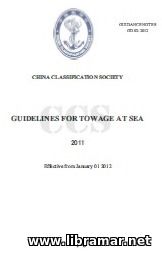 Здесь пишем содержание для краткого описанияThese Guidelines have been released by CCS to provide necessary technical guidance for surveyors conducting ocean towing surveys. As implied by the title, the document applies to the sea towage operations, excluding salvage operations, involving following types of towed objects - non-self propelled ships, including pontoons and barges and various floating structures, FDD and floating installations, MODUs and other floating and offshore installations, motor vessels that have lost their propelling capability (but still not the salvage and emergency).
The provisions of this document do not apply to towing of engineering ships, such as dredgers or crane vessels, within their operational areas and towage of any ships within harbours. The Guidelines have been divided in five parts as follows - General Provisions (purpose, application, requirements, definitions, documentation, information, surveys, towage operation management, forecasts, inspection, certification, etc.) - Towed Object - Vessel and Towed Object - MODU (with all necessary technical information and guidance on proper organization, strength and stability issues involves, anchoring equipment, towing points, lashing and securing, etc.), Towing Vessels (general info, communication equipment, transfer of personnel, etc.), Towing Equipment and Gears (towing winches, equipment and gears)...
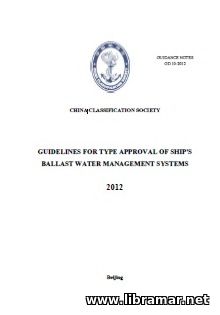 The requirements for approval of the BWM are listed in the Reg. D-3 of the BWM Convention. The present Gudelines have been prepared to implement the applicable provisions of regulations D-2 and D-3 of the above noted Convention and perform type approval of the systems as per the IMO G8 requirements.
Additionally, this publication may serve as a Guidance for ship owners and manufacturers of the BWMS on evaluation procedures that the associated equipment will undergo and requirements placed on the BWM systems. Contents - General; Requirements for the approval of BWMS; Procedures of type approval and certification; General technical requirements; Document requirements for approval applications; Pre-test evaluation; Land-based testing; Scaling of product systems; Shipboard testing; Environmental testing; Installation survey and commissioning; Type approval certificate of BWMS; Diagrammatic arrangement of possible land-based tests; Procedure for approval of BWMS making of active substances.
The declared purposes of this document are to provide formal interpretation of the performance and test requirements for the approval of BWMS, assist in choosing the appropriate design as well as construction and operation requirements for BWMS approval, provide the industry with the uniform interpretation and application of D-3 requirements, etc.
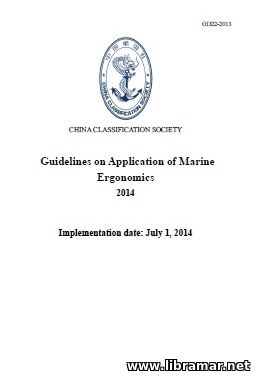 The present CSS Guidelines give clear and easily understandable guidance related to applying the basic ergonomics principles in design for noise/lighting/vibration/ventilation, and access arrangements. Chapter 1 contains objectives of the present Guidelines as well as related definitions and terminology, including the abbreviations. Chapter 2 explains people should always treat the human element as the key aspect and how exactly the regulations governing the shipping industry are nowadays putting the increasing emphasis on the matters relating to the human element.
In the third chapter of this paper the authors made a good attempt trying to present a brief though comprehensive explanation of why the human element is used for the recommendation criteria - lighting and ventilation, noise and vibration, various access arrangements - and present detailed recommendations for the structural arrangement for each of the above stated criteria.
Annex A provides the ship designers with required measurement values for some of the above mentioned criteria that could possibly aid them when applying design recommendations. They provide designers with some supplementary info that can be used in the process of making design judgements. The second Annex presents a complete list of all relevant standard documents relating to the good ergonomic practice.
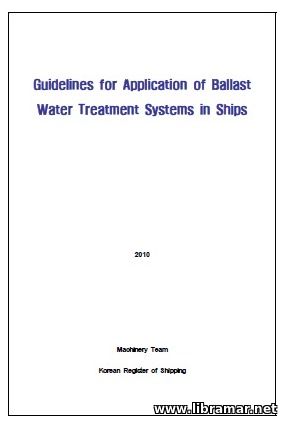 The Machinery Team of the Korean Register of Shipping released the present official Guidelines some years ago, namely in 2010. The world's traffic volume have drastically increased over the last several decades and it resulted in serious damages to the surrounding environment which was caused by invasive species contained in vessels' ballast water.
As a final result of almost fifteen years of negotiations held between all of the IMO members, the BWM was adopted in 2004. There are still many questions that are relating to the installation of the BWTS, i.e. treatment systems, on ships, raised by shipyards and ship owners as the effective date of the Convention in question is approaching. However, it shall be taken into account as necessary, that subject Convention will enter into force only after it has been adopted by not less than thirty IMO members with their combined fleet not less than thirty-five percent of the combined gross tonnage of the world's merchant shipping. KR outlined all reference information for the selection and installation of such treatment systems by vessel type.
These Guidelines shall be considered as interim ones and have been developed on the basis of the discussions by date. We do hope that the book would help the shipyard inspectors, ship owners and class surveyors in their day-to-day work.
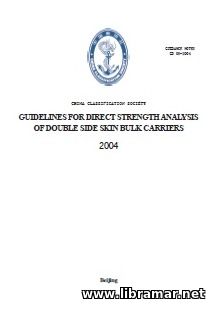 The present Guidelines were developed and published by Chinese Class Society. They are intended to address nearly all aspects of direct strength analysis conducted for the bulk carrier type vessels constructed with the double skin.
The Guide starts with the chapter containing some general requirements that are usually applicable to such analysis; it also explains all definitions used throughout the publication, for easier further understanding. The second chapter deals with the direct loads analysis and also provides some general requirements in this regard, together with the information on the still water and wave loads.
Talking about the design loads, the publication addresses the cargo pressure in the cargo hold, external pressure of the sea, and bending moments on end plates. The coordinate definitions and model meshing have been deal with in the chapter dedicated to the structural model. Then there are chapters on the boundary conditions, loading conditions and strength criteria. The last chapter of the Guide describes the various methods of buckling strength evaluation. Truly useful publication, bearing in mind the limited number of guides dealing with this sort of analysis.
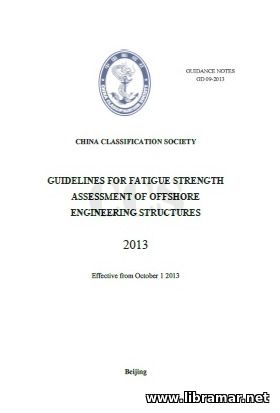 These official CCS Guidelines were developed and released by China Classification Society. They shall apply to the welded steel offshore structures, such as mobile units, jacket units, FSO, FPSO etc. In case the offshore structure is of some special or novel structural type, special consideration is to be given to the fatigue strength assessment.
Here is the list of the topics that have been covered in this publication - Genera (including definitions and some info on the S-N curve approach and fracture mechanics method)l; Fatigue analysis based on S-N curves. Stress concentration factors have been covered together with the hot spot stress calculation; Safety factor of fatigue was explained; Various methods of fatigue analysis, such as simplified FAM, method based on fracture mechanics and spectral-based fatigue analysis method; Improvement methods of fatigue life; Extended fatigue life; Structural detail classification corresponding to S-N curve fatigue assessment; Parametric formulae for calculation of the stress concentration factors of tubular joints; Stress concentration factors for penetrations with reinforcements.
We hereby advise the designers and analysts of the offshore structures of the fact that in some cases technical criteria by a cognizant regulatory authorities may significantly differ from what is contained in these Guidelines...
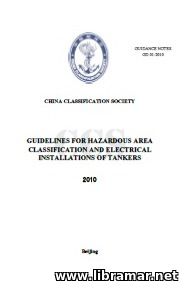 The present China Classification Society's Guidelines were developed to apply to tankers carrying flammable liquid cargoes in bulk. The document is to be used by the designers, ship constructors and class surveyors of tankers for reference; it shall be noted as necessary that these Guidelines do not the relevant requirements of CCS Rules as well as of the IEC publications that are in force.
The term "flammable" used throughout the present Guidelines includes hazard results that are determined by the flash- and boiling point, flammability and spontaneous ignition temperature of the transported cargo, and hazard results from the cargo reacting with other materials. The document has been divided into six major parts. The first is providing some general info together with the definitions used and list of documentation; the second part addresses the area classification, following two parts are dedicated to the shipboard electrical systems and electrical equipment.
The last two parts of the publication cover the installation aspects (such as proper selection and correct installation of the electrical cables, their connection and joints), and inspection and maintenance issues.
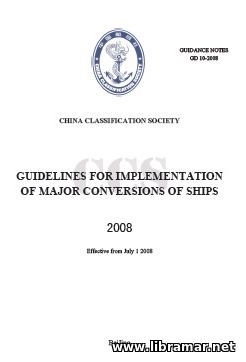 These Guidelines were prepared by CCS professionals with the intention to provide the industry with the necessary technical guidance concerning implementation of the requirements applicable to the vessels undergoing major repairs or alterations to their hulls or outfitting, as well as the ones under modifications.
The document shall apply to all CCS-classed ships and to the ships proposed for classification with this Society and engaged in international voyages. In case of the vessels undergoing major conversions prior to the date when these Guidelines enter into force, the provisions contained in this document shall be complied with as far as practicable. Here is the brief contents of these official CCS Guidelines: General; Construction - subdivision and stability, machinery and electrical installations; Construction - fire protection, detection and extinction; Lifesaving appliances and arrangements; Pollution prevention; Hull structure and outfit; Machinery and electrical installations and systems; Control of hull conversion project; Appendix - Provisions of the applicable standards for conversion of oil tankers to ore carriers, bulk carriers and double hull oil tankers.
« 1 2 ... 20 21 22 23 24 ... 29 30 » |







